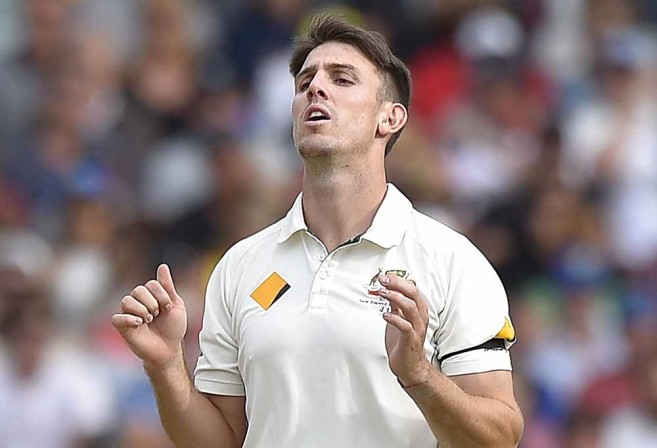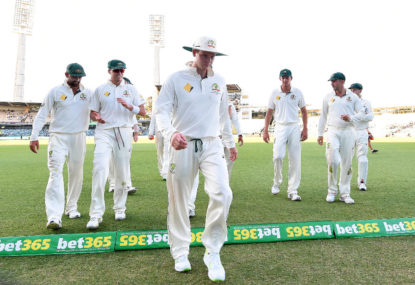Let’s face facts. Australia is staring the down the barrel of a sizeable series defeat in India.
When last they toured India, in 2013, the result was four-nil in favour of the home side.
India is a better side four years on. Australia may not be when it comes to playing on Indian pitches.
But, there are some things the tourists can do to improve their prospects.
Number 1: Put their faith in pace
When Geoffrey Boycott sees below par bowling he has a favourite expression, “My Mother could play that with a stick of rhubarb”.
Unfortunately, that could be the case for India’s batsman when facing Australia’s spin.
No matter which combination of spinners Australia utilises in this series they are unlikely to cause major concerns for India’s powerful batting line-up.
Captain Steve Smith said yesterday, “I guess it’s whether we play three spinners and either one quick or two quicks and no all-rounder, or a spin-bowling all-rounder”.
There are five spinners in the tour party – off-spinners Nathan Lyon and Glenn Maxwell; left-arm finger spinners Steve O’Keefe and Ashton Agar; and uncapped leggie Mitchell Swepson.
The skipper can also bowl leg-spin.
The specialist fast bowlers are Mitchell Starc, Josh Hazelwood and Jackson Bird, while the only pace bowling all-rounder is Mitch Marsh.
It would be a ridiculous decision to choose just one of the fast bowlers, who would no doubt be Starc. Hazlewood must play.
In the debacle in Sri Lanka last year, Starc captured 24 wickets at 15.2. Hazlewood picked up seven wickets at 32.7 with a miserly economy rate of 2.7.
That was in a series where Sri Lanka’s spinners took 54 of the 60 Australian wickets to fall.
The pair are likely to again be the trumps in this series.
Lyon and O’Keefe are the first-choice spinners for the opening Test.
That leaves one of Marsh, Maxwell, or Agar for the all-rounders slot.
I would go with Marsh as he offers the best prospect of stemming the run flow and that will be a key for Australia.
If Australia cannot build pressure they will have no chance of getting on top of the Indian batsmen.
Yes, Marsh has struggled to get wickets in Asia – five Tests for figures of 2-228 – but he has an economy rate of 3.0 in that part of the world.
He was not backed up by his fieldsmen in Sri Lanka last year with several catches put down.
He hits the pitch hard and can bowl tight wicket to wicket spells. In the latter stages of matches where variable bounce comes into play he his style will be suited.
Maxwell has played three Tests in Asia for seven wickets at 38.7, however his economy rate has been 4.8.
The choice of two left-arm orthodox would not be ideal which will likely see Agar overlooked.
Lyon will certainly be targeted, especially by Kohli. The Indian batsman will be keen to dent his confidence, and with it, put pressure back on Smith.
He was savaged in the lead-in game against India A at Mumbai.
Australia’s spinners are likely to regularly leak runs. Naming three of them will likely not help their cause.
It is worth remembering that Australia’s 2004 series win, their only one since 1970, was built around pace.
Shane Warne played almost a stock role in that series with many of overs delivered from around the wicket into the footmarks of the right-handers.
At the other end, Jason Gillespie, Glenn McGrath and Michael Kasprowicz bowled a consistent dry line wide of off-stump. It was an approach that frustrated the Indian batsmen into error.
While Mitch Marsh has a 19-Test career batting average of 23.2, his ten innings in Asia have produced an average of 32.7.

It is a fair return when compared to David Warner (33.2 in 18 innings) and Usman Khawaja (19.2 in seven innings).
He is a good fit for this series at number six.
Number 2: Concentration in the field
In the 3-0 loss in Sri Lanka, Australia’s fielding was well below par.
Several should straight forward catches were grassed. That can simply not happen in this series.
Players like Virat Kohli and Cheteshwar Pujara are renowned for batting for long periods – Kohli has made a double century in each of his last four series.
Giving lives to players of that ilk will be fraught with danger.
Concentration in the field will be vital, something that is not made easy in the heat and humidity of the sub-continent.
Chances will likely come infrequently and they must be taken when they are.
The ground fielding must also be sharp. All bowlers like to work on the one batsman in order to implement a pre-determined plan.
Number 3: Matthew Wade must start the series well
Just as the fieldsmen must be on song, so do does the ‘keeper, perhaps even more so in Indian conditions.
Matthew Wade will be perhaps the most heavily scrutinised member of the squad. There has long been a question mark over his ability keeping to spin.
It is imperative that Wade is up to the task in the early stages of the series. He needs to build confidence.
The first two Tests are played back-to-back. If he struggles early it will cause real issues.
While Peter Handscomb is effectively the reserve wicket-keeper, Smith and the selectors will not be wanting him to take up the gloves.

As a nascent batsman at Test level they will not want his workload doubled by having to keep.
He is also a very fine short leg fieldsman, and in India, that is a crucial position.
Number 4: Make the game the primary focus
Modern Indian cricket teams are very different from those of yesteryear. For decades, India played a meek brand of cricket. They were often subservient to their opponent.
Their outlook on the field was almost an extension of their life off it. Many Indians carried what was akin to an inferiority complex as a result of their colonial history.
They were timid on the field and would often disintegrate under verbal assault from the opposition.
Modern day Indian teams are a different beast. They give as good as they get, and some like Kohli, thrive on verbal confrontations.
Australia needs to make the game their focus and not get drawn into verbal stoushes.
Number 5: Successfully marry patience and aggression
In a place like India, facing the likes of Ravichandran Ashwin and Ravindra Jadeja it is often just a matter of time before they have their man.
Patience at the crease is important but allied to that there must be aggression.
India’s spinners will be all over the batsmen and being becalmed at the crease is something the tourists cannot let happen.
They have to rotate the strike regularly, especially when left and right-handers are at the crease.
The threat posed by Ashwin and Jadeja will escalate if they are permitted to bowl to the same batsman for long periods of time.































































































